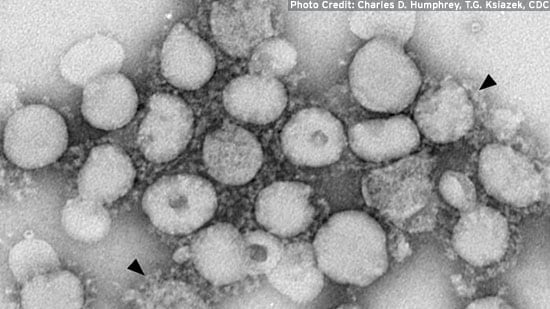
SARS
What is SARS
Severe acute respiratory syndrome (SARS) is a viral respiratory illness caused by a coronavirus. It was first reported in Asia in February 2003, likely originating in China. Over the next few months, the illness spread to more than two dozen countries in North America, South America, Europe and Asia before the SARS global outbreak of 2003 was contained. No new outbreaks or cases have been reported since mid-2003.
WHAT ARE THE SYMPTOMS?
SARS begins with a fever greater than 100.4°F (38.0°C). Other symptoms may include headache, an overall feeling of discomfort and body aches. Some people also have mild respiratory symptoms at the outset. Less than 20 percent of patients have diarrhea. After two to seven days, SARS patients may develop a dry cough. Many patients develop pneumonia.
HOW IS IT TRANSMITTED?
SARS is spread by close person-to-person contact. The virus is transmitted most easily when patients cough or sneeze, creating respiratory droplets that can be propelled up to a distance of three feet. Virus droplets cause illness when they contaminate mucous membranes in the mouth, nose or eyes. There is no evidence of airborne transmission. However, the virus can be picked up from hard surfaces where droplets have been deposited, as it has been demonstrated to survive for several hours.1 The CDC urges caution, since epidemiological and laboratory evidence suggests a role of the environment in transmission, but no cases have been linked to transmission from dishes or eating utensils.
Most cases of SARS involved people who cared for or lived with someone with SARS, or had direct contact with infectious material (for example, respiratory secretions) from a person who had SARS. An infected person may continue to shed the virus for a significant time period (10 to 14 days) after acute respiratory symptoms and fever are gone, but the CDC says that there have been no cases attributed to shedding of virus particles by patients before symptoms were observed.
It is possible, although not documented, that SARS can be spread more broadly through the air or by other ways that are currently unknown.
HOW IS IT CONTROLLED?
Since SARS is primarily spread via close personal contact, attention to personal hygiene is key, including proper handwashing and covering coughs and sneezes. Standard infection control procedures and the use of personal protective devices should be considered when caring for a SARS patient; refer to information from the World Health Organization and Centers for Disease Control for more specific information related to the scope of the illness.2 3
For assistance with this topic or other food safety questions for your operation, please Contact Us.
REFERENCES AND FURTHER INFORMATION


